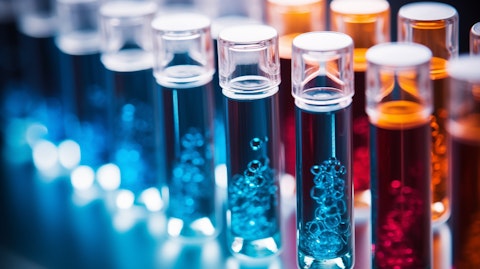Kamada Ltd. (NASDAQ:KMDA) Q1 2025 Earnings Call Transcript May 14, 2025
Kamada Ltd. reports earnings inline with expectations. Reported EPS is $0.07 EPS, expectations were $0.07.
Operator: Greetings, and welcome to the Kamada First Quarter 2025 Earnings Conference Call. At this time, all participants are in a listen-only mode. A question-and-answer session will follow the formal presentation. [Operator Instructions]. As a reminder, this conference is being recorded. It is now my pleasure to introduce Brian Ritchie with LifeSci Advisors.
Brian Ritchie: Thank you. This is Brian Ritchie with LifeSci Advisors, and thank you all for participating in today’s call. Joining me from Kamada are Amir London, Chief Executive Officer; and Chaime Orlev, Chief Financial Officer. Earlier today, Kamada announced its financial results for the three months ended March 31, 2025. If you have not received this news release, please go to the Investors page of the company’s website at www.kamada.com. Before we begin, I would like to caution that comments made during this conference call by management will contain forward-looking statements that involve risks and uncertainties regarding the operations and future results of Kamada. I encourage you to review the company’s filings with the Securities and Exchange Commission, including, without limitation, the company’s Forms 20-F and 6-K, which identify specific factors that may cause actual results or events to differ materially from those described in the forward-looking statements.
Furthermore, the content of this conference call contains time-sensitive information that is accurate only as of the date of the live broadcast, Wednesday, May 14, 2025. Kamada undertakes no obligation to revise or update any statements to reflect events or circumstances after the date of this conference call. With that said, it is my pleasure to turn the call over to Amir London, CEO. Amir?
Amir London: Thank you, Brian. My thanks also to our investors and analysts for your interest in Kamada and for participating in today’s call. I’m pleased to report on our strong first quarter results, representing double digit profitable growth and a continuation of the operational performance we generated over the course of 2024. Total revenues for the first quarter were $44 million, an increase of approximately 17% year-over-year. Adjusted EBITDA was $11.6 million, an increase of approximately 54% year-over-year. Our growth compared to Q1 2024 was primarily as a result of an increase in sales of GLASSIA and KAMRAB in ex-U.S. markets, as well as VARIZIG sales and GLASSIA royalties income. We expect to continue to generate profitable growth throughout the diversity of our portfolio and disciplined management of operational expenses through the remainder of 2025.
Based on a positive outlook for the year, we are reiterating our 2025 annual guidance of anticipated annual revenues of $178 million to $182 million and $38 million to $42 million of adjusted EBITDA. Importantly, the midpoints of our 2025 guidance represent increase of approximately 12% in revenues and approximately 17% in adjusted EBITDA, respectively, over our 2024 results. As our expectation for strong top and bottom line growth indicate, we are excited for the near-term prospects of our business. We are even more excited about the longer term opportunities ahead of us as we continue to progress on our four-pillar growth strategy, consisting of organic commercial growth, business development and M&A transactions, our plasma collection operation and advancement of our pivotal Phase 3 inhaled Alpha-1 program.

To this end, last week, we announced initiation of a comprehensive post-marketing research program for CYTOGAM, which we believe will help demonstrate the advantages of the product in the prevention and management of CMV disease. This program, which consists of 10 different studies, most of them as investigator-initiated studies, was developed in collaboration with leading KOLs and is directed at advancing CMV disease management through novel strategies. Studies will focus on late onset CMV prevention and mitigation of active CMV disease, exploring alternative dosing strategies and investigating potential new applications of CYTOGAM. Although CMV disease continues to be a significant risk factor for organ rejection and mortality in transplantation, for years no new up-to-date clinical data regarding the benefits of CYTOGAM were published.
The data generated by this program will support further product utilization. As part of our activities to advance organic growth, I’m happy to update that following our first biosimilar product launch in Israel last year, which is expected to generate approximately $2 million in revenue this year, we expect to launch two additional biosimilars later this year and have several others in the pipeline to be launched in the coming years. We expect that this portfolio will become an increasingly important portion of our distribution business with annual sales of between $15 million to $20 million within the next five years. Moving to business development and M&A. During 2025, we expect to secure compelling new business development, in-licensing, collaboration and/or M&A transactions, which will enrich our portfolio of marketed products and complement our existing commercial operation.
We anticipate that such agreements will generate operational and/or commercial synergies with our current commercial portfolio and will support future profitable growth. Also, during the recently completed quarter, we expanded our plasma collection operation with the opening of our third location in San Antonio, Texas. The 11,000 square foot San Antonio Center will support over 50 donor beds with an estimated total collection capacity of approximately 50,000 liters annually. Once they are at full collection capacity, we anticipate that our Houston and San Antonio collection centers will each contribute annual revenues of between $8 million to $10 million in the sales of normal source plasma. Turning now to our ongoing pivotal Phase 3 InnovAATe clinical trial for inhaled Alpha-1 Antitrypsin therapy.
We continue to advance this program with its revised enrollment goal of 180 subjects, and we are on track to conduct an interim futility analysis by the end of 2025. With that, I’ll now turn the call over to Chaime for a detailed discussion of our financial results for the first quarter of 2025. Chaime, please go ahead.
Chaime Orlev: Thank you, Amir. As Amir stated at the top of the call, our results for the first quarter of the year were strong. Total revenues were $44 million in the first quarter compared to $37.7 million in the first quarter of 2024. As Amir mentioned, the increase in revenues stemmed from the diversity of our portfolio and were primarily attributable to increased sales of GLASSIA and KAMRAB in ex U.S. market as well as VARIZIG sales and GLASSIA royalties income. Gross profit and gross margins were $20.7 million and 47% in the first quarter of 2025 compared to $16.7 million and 44% in the first quarter of 2024. The increase in both matrices is attributable to improved product sales mix. Operating expenses, including R&D, sales and marketing, G&A and other expenses totaled $13 million in the first quarter of 2025 as compared to $12.7 million in the first quarter of 2024.
The marginal increase in operating expenses is indicative of our ability to manage operational expenses while continuing to generate meaningful revenue growth. Net income was $4 million or $0.07 per share in the first quarter of 2025, up 67% from the $2.4 million or $0.04 per share in the first quarter of 2024. Adjusted EBITDA was $11.6 million in the first quarter compared to $7.5 million in the first quarter of 2024, representing a 54% year-over-year increase. While the dividend payment declared in March was only paid after the end of the quarter, we continue to maintain a strong cash position that is planned to be used to fund new business development initiatives. With that, we will turn the call over to questions.
Q&A Session
Follow Kamada Ltd (NASDAQ:KMDA)
Follow Kamada Ltd (NASDAQ:KMDA)
Receive real-time insider trading and news alerts
Operator: [Operator Instructions]. Our first question is from Annabel Samimy with Stifel.
Annabel Samimy: Hi all, thanks for taking my question. Great start of the year. I had some questions around the different growth contributors. I noticed that CYTOGAM has been cited as a growth contributor this quarter. So I was just wondering, with your expanded investment in clinical studies for CYTOGAM, is that — should we read into anything that there’s — what prompted this? Has it reached a plateau right now? Or maybe does it signal anything for the potential to update guidelines based on the data that you have to date? Just wanted to understand the decision for making this investment. So I guess that’s the first question. I have some follow-ups.
Amir London: Thanks, Annabel. So we emphasized the basically year-over-year growth — and basically, Q1 2024 was kind of similar to Q1 2024 in terms of the sales. Just a reminder, end of 2023, we launched the new batches from our own production. So Q1 of 2024 was strong with this fresh inventory that was basically shipped to the market. So we had a strong quarter back then. So when comparing the quarter-to-quarter, year-over-year, CYTOGAM didn’t have a major contribution to the growth. The growth came from other products. We’re very happy to see the strength of our portfolio, the diversity of our portfolio, including GLASSIA ex-U.S., KAMRAB ex-U.S., VARIZIG in the U.S. market and the GLASSIA royalties had a significant contribution to the growth of the business.
In general, we spoke about it in previous quarters. The fact that we have six FDA-approved products and we’re currently active in over 35 different countries, territories makes a very significant, a very strong portfolio that can continue growing organically in the next few years.
Annabel Samimy: Okay. And just any thoughts on how the guidelines might be updated for CYTOGAM for CMV rather? And is there anything to read into the fact that you’re expanding these studies? Does that mean that you just need more data to update these guidelines?
Amir London: So the idea to conduct multiple studies in order to basically present new fresh clinical data, something we started working already in 2023. It took us time to work with the pool of KOLs, creating advisory board and basically work with each one of those to identify what is like the key set of data that will be important for the community to see. So it takes time, of course, to design, develop those clinical studies. And this has matured to a point that we were in a position that we could announce this comprehensive program. Between 2023 when we started and now when we announced it, we already had like three different presentations, posters in industry conferences. And we are starting to see that there is positive impact on this work in the field working with the physicians.
Changing guidelines takes time. Recently, there was a meeting of the consortium that basically the KOLs that work on CMV prevention, CMV management guidelines. And there is a modest change to the guideline. We expect that with new data, we are going to be able to prove that CMV immunoglobulin has a significant advantage in the prevention and management of CMV and that it will be well reflected in future guidelines.
Annabel Samimy: Okay got it. And just — I guess I can have a ton of questions, but I’ll just cut it to one. Just have to ask the extent to which you’re globally — you have a global business. Can you just sort of lay out how you think about the tariffs that are being posed right now? I know for right now, pharmaceuticals are excluded, but have you thought about the potential impact and how you might be protected just having plasma here or where you’re sourcing your different products? Any kind of calculation that you’ve made on in a worst-case scenario, what kind of impact that might have on margins or on the business overall?
Amir London: Okay. Chaime will answer this question. Chaime, please?
Chaime Orlev: Yes. So we conducted an evaluation of the issue. And our understanding based on currently available information is that there should be no direct impact on sales of our specific products. However, as we know, this is an evolving situation, which we will keep on monitor and we’ll advise in the future if our conclusion changes. I would also note that at the present time, it is not possible to fully assess the potential indirect effect of the tariff discussions over global trade and how that might play in. But based on the analysis we made thus far, we do not think there is going to be a direct impact on our business.
Annabel Samimy: Okay. Great. And just if I can squeeze in one more. Any updates on what percent you are enrolled for InnovAATe at this point?
Amir London: So we’re at around 55% enrollment, and we are making good progress in working on the futility analysis. We will have a cutoff of the data in the second part of the year. And soon after that, the data will be available for the DSMB to run the statistical analysis for the futility analysis.
Annabel Samimy: Okay, great. Thank you.
Amir London: Thank you.
Operator: Our next question is from James Sidoti with Sidoti & Company.
James Sidoti: Hi, good morning. Thanks — good afternoon, actually. Thanks for taking the question. Just a follow-up on the CYTOGAM post-marketing study. Can you talk a little bit about the timing of that? When do you expect that to be completed?
Amir London: Because it’s an array of 10 different studies. So each one of those has its own time line. Some are things that are done quicker, especially the non-human clinical studies, but more of kind of the in vitro analysis that we are doing. So some of it will be available already later this year into 2026 and some of the work will continue all the way to 2027, 2028. In general, I’ll say it’s around a 4-year program that we have launched across multiple sites, multiple KOLs and basically kind of covering the majority of the relevant CMV management and preventive in organ transplantation.
James Sidoti: And then I know you addressed the tariffs, but one of the other changes in the U.S. in the past few months is the cutbacks in NIH spending. Do you expect those to have any impact on your business?
Amir London: Not currently. No. So with our current understanding of the potential changes in the regulations, we don’t anticipate that this will have an impact on the business because of the nature of the business and the hospital critical care type of treatment that we are doing, pretty unique type of medicines. Again, like Chaime mentioned about the tariff, is there going to be any change in our understanding of situation, we will update on this.
James Sidoti: Okay. And then the last one for me, detail in the quarter. The tax rate, you reported a 40% tax rate compared to a 3% tax rate a year ago. I guess two questions. What happened? And are those real cash taxes? Or was that a non-cash expense?
Amir London: Chaime?
Chaime Orlev: The tax changes in deferred tax liability, you can refer to our cash flow to see that it had no cash effect.
James Sidoti: Okay. And should we expect you to report similar tax rates going forward?
Chaime Orlev: Well, through 2025, I think we’re going to be fluctuating a little bit in terms of our tax expenses mainly because of shifts between deferred tax assets and deferred tax liabilities. And I expect that by the end of this year, it would smooth out. And going forward, you’ll be able to see our effective tax rate more clearly. But as of now, we have yet — we’re still using NOLs, so we’re not paying taxes. We expect to be in a taxable income and start paying taxes at the end of 2025 or beginning of 2026.
James Sidoti: Okay, great. That was my next question. Thank you very much.
Operator: Thank you. I would like to hand the floor back over to Brian Ritchie for additional questions.
Brian Ritchie: Thank you. Just one question from the web, Amir. What does the strong start to Q1 mean for your annual guidance?
Amir London: Great question. So, of course, we are going to — so we had a strong first quarter. We are going to monitor progress during the second quarter. And although we should be evaluated on an annual basis, we will definitely see if this strong performance continues. And if that’s the case, we will update our guidance moving forward.
Brian Ritchie: Thanks, Amir. I’ll turn the floor back over to you for closing comments.
Amir London: Thank you. Thank you, Brian. So in closing, we continue to invest in the four-pillar growth strategy, continued progress made in all across our business, organic growth of our existing commercial portfolio, business development and M&A opportunities to support and expedite the growth, expansion of our plasma collection operation and progression of our AAT therapy program. We look forward to continue to support clinicians and patients with important life-saving products that we develop, manufacture and commercialize. And we thank you all for your support, and we remain committed to creating long-term shareholder value. We hope you all stay healthy and safe. Thank you for joining us today. Good luck.
Operator: This concludes today’s conference. You may disconnect your lines at this time. Thank you for your participation.
Follow Kamada Ltd (NASDAQ:KMDA)
Follow Kamada Ltd (NASDAQ:KMDA)
Receive real-time insider trading and news alerts




